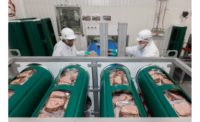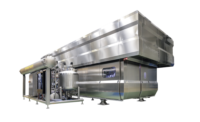Exclusive interview: Q&A on high-pressure processing and Listeria outbreaks

Food Safety Strategies recently was able to talk to Dr. Errol Raghubeer, vice president of food science and microbiology, JBTAVURE, about HPP (high-pressure processing) and the U.K. Listeria outbreak.
Food Safety Strategies: How could have HPP helped the recent listeria outbreak in the UK?
Errol Raghubeer: HPP is a well-established post lethality treatment (PLT) for the elimination of foodborne pathogens in many foods and beverages. It is widely used in the meat industry to eliminate Listeria monocytogenes in RTE/Deli meat and poultry.
FSS: In the U.S., the RTE meat and poultry industry have experienced several recalls due to Listeria. What was HPP’s (and/or your role) in resolving the U.S.’s RTE meat and poultry industry listeria recalls?
ER: In 2002, amidst several food poisoning outbreaks and recalls for Listeria monocytogenes in RTE/deli meats and poultry products, JBTAVURE was contacted by the USDA for information on the efficacy of HPP in controlling listeria in these products. Instead of sending available data, we conducted a comprehensive inoculation study with Listeria monocytogenes in typical RTE meat products and submitted the results to the US FSIS/USDA along with results of other validation studies and requested that HPP be approved as a post-lethality treatment for Listeria monocytogenes in RTE meat. The FSIS issued JBT-JBTAVURE a “letter Of No Objection” in March 2003 and included HPP as a viable post-package PLT in 2006 for the control of listeria in RTE meat (9 CFR 430.4 2006, 2017). Similar filings with additional supporting data were submitted to Health Canada/Canadian Food Inspection Agency (CFIA) that resulted in the subsequent approval by CFIA/Health Canada for the control of Listeria monocytogenes in meat and poultry. (www.inspection.gc.ca/food/archived-food-guidance/meat-and-poultry-products/manual). Health Canada considers HPP a PLT for RTE meat to be satisfactory when it achieves at least a 3-log reduction of L. monocytogenes at 6,000 bars for 3 minutes. These and greater reduction levels are consistently achieved with HPP based on intrinsic factors of the RTE meat and poultry products.
FSS: What foods are more prone to Listeria?
ER: RTE/Deli meat, hot dogs and unpasteurized milk and dairy products have frequently been implicated in L. monocytogenes food poisoning outbreaks. It a ubiquitous environmental organism and is commonly found in soil, water, silage, and animal feces. It is found in food production facilities such as in RTE meat/deli processing plants and equipment, particularly slicing equipment.
FSS: What food companies in the U.S. and globally does JBTJBTAVURE work with to prevent Listeria?
ER: Several food companies in the US and globally use JBT-JBTAVURE HPP equipment for food safety, shelf-life extension and other food processing benefits. In the US, Avomex, Keller TX (now Wholly Guacamole) was the first company to implement HPP for commercial guacamole production in 1997. Hormel Foods and Perdue Farms soon followed for RTE meat products to prevent against bacterial foodborne issues. Globally, JBT-JBTAVURE HPP systems are in use in several countries in Europe, Asia, Australia, New Zealand, Africa, and the Middle East. Although many of these systems are owned and operated by food producers, JBT-JBTAVURE HPP equipment are used globally by companies that provide HPP services to both small and large companies that use these facilities to process their products for a fee. The two largest categories of products that use these toll facilities are RTE/Deli meat and poultry and fruit-juice beverages both in the North America and elsewhere. It is reasonably correct to say that much, if not most of the RTE/Deli meat and poultry products sold in the US are treated by HPP, particularly products labelled as natural and do not have chemical preservatives.
FSS: Looking at the quality index shelf-life graph below for RTE meat and poultry products, it looks like HPP is more effective than standard processing for RTE meat and poultry products shelf life. What makes HPP is more effective than standard processing?
ER: HPP is commonly applied to packaged products that have gone through the final lethality treatment, normally heat treatment. Therefore, products that are exposed after final treatment are susceptible to contamination from plant equipment and handling. Minimal to moderate heat treatment is usually applied to meet pasteurization requirements for pathogen control due to negative effects of heat on quality and yield. However, this heat treatment is usually not quite adequate for significant reduction of certain food spoilage microflora such as lactic acid bacteria. This is particularly true for companies that are reducing or eliminating preservatives in their RTE meat and poultry products and relying only on the PLT for microbial control. HPP does not have any adverse effects on the quality and yield of RTE meat and deli products so, HPP conditions are selected not only to eliminate pathogens such as L. monocytogenes but also to reduce the levels of spoilage microorganisms, particularly strains of lactic acid bacteria. This results in at least twice the length of shelf-life normally seen with standard processes.
Looking for a reprint of this article?
From high-res PDFs to custom plaques, order your copy today!










